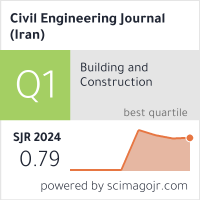Influence of Shear Strain on the Deflection of Girders
Downloads
Doi: 10.28991/CEJ-2024-010-05-04
Full Text: PDF
Downloads
[2] Slaughter, W. S. (2002). The Linearized Theory of Elasticity. Birkhäuser Boston, Boston, United States. doi:10.1007/978-1-4612-0093-2.
[3] Dvornik, J., & Lazarević, D. (2007). The Role of Creativity and Engineering Judgment in Construction Work. Građevinar, 59(03), 197-207.
[4] Timoshenko, S., & Goodier, J. N. (1951). Theory of elasticity. McGraw-Hill Book, New York, United States.
[5] Hjelmstad, K. D. (2007). Fundamentals of structural mechanics. Springer Science & Business Media, New York, United States.
[6] Dvornik, J., Lazarević, D., & Bićanić, N. (2019). On the principles and procedures of budgeting of building structures. Faculty of Civil Engineering, University of Zagreb, Zagreb, Croatia. doi:10.5592/bo/2019.978-953-8168-31-4.
[7] Ibrahimbegovic, A., & Mejia-Nava, R.-A. (2023). Structural Engineering. In Lecture Notes in Applied and Computational Mechanics. Springer International Publishing, Cham, Switzerland. doi:10.1007/978-3-031-23592-4.
[8] R. Eugster, S. (2015). Geometric Continuum Mechanics and Induced Beam Theories. In Lecture Notes in Applied and Computational Mechanics. Springer International Publishing, Cham, Switzerland. doi:10.1007/978-3-319-16495-3.
[9] Goldberg, D. (1991). What every computer scientist should know about floating-point arithmetic. ACM Computing Surveys (CSUR), 23(1), 5–48. doi:10.1145/103162.103163.
[10] Dvornik, J., & Lazarević, D. (2005). Shortcomings of Calculation Models of Engineering Structures. Građevinar, 57(04.), 227-236.
[11] Bathe, K. J. (1996). Finite element procedures. Prentice Hall, New Jersey, United States.
[12] Öchsner, A. (2021). Classical Beam Theories of Structural Mechanics. Springer International Publishing, Cham, Switzerland. doi:10.1007/978-3-030-76035-9.
[13] Obert, L., & Duvall, W. I. (1967). Rock mechanics and the design of structures in rock. John Wiley and Sons, Hoboken, United States.
[14] Ahmed, A. M., & M. Rifai, A. (2021). Euler-Bernoulli and Timoshenko Beam Theories Analytical and Numerical Comprehensive Revision. European Journal of Engineering and Technology Research, 6(7), 20–32. doi:10.24018/ejeng.2021.6.7.2626.
[15] Rahmani, F., Kamgar, R., & Rahgozar, R. (2020). Finite element analysis of functionally graded beams using different beam theories. Civil Engineering Journal (Iran), 6(11), 2086–2102. doi:10.28991/cej-2020-03091604.
[16] Gaur, A., & Dhurvey, P. (2020). Comparative Study of Beam Theories on the Effect of Span-Depth Ratio for Symmetric and Un-symmetric Loadings. IOP Conference Series: Materials Science and Engineering, 936(1), 012047. doi:10.1088/1757-899X/936/1/012047.
[17] Zhang, G. Y., & Gao, X. L. (2020). A new Bernoulli–Euler beam model based on a reformulated strain gradient elasticity theory. Mathematics and Mechanics of Solids, 25(3), 630–643. doi:10.1177/1081286519886003.
[18] Perez-Garcia, C., Aranda-Ruiz, J., Zaera, R., & Garcia-Gonzalez, D. (2022). Beam formulation and FE framework for architected structures under finite deformations. European Journal of Mechanics, A/Solids, 96. doi:10.1016/j.euromechsol.2022.104706.
[19] Yawei, D., Yang, Z., & Jianwei, Y. (2020). Exact solutions of bending deflection for single-walled BNNTs based on the classical Euler-Bernoulli beam theory. Nanotechnology Reviews, 9(1), 961–970. doi:10.1515/ntrev-2020-0075.
[20] Alavi, S. E., Sadighi, M., Pazhooh, M. D., & Ganghoffer, J. F. (2020). Development of size-dependent consistent couple stress theory of Timoshenko beams. Applied Mathematical Modelling, 79, 685–712. doi:10.1016/j.apm.2019.10.058.
[21] Franza, A., Acikgoz, S., & DeJong, M. J. (2020). Timoshenko beam models for the coupled analysis of building response to tunnelling. Tunnelling and Underground Space Technology, 96. doi:10.1016/j.tust.2019.103160.
[22] Davari, S. M., Malekinejad, M., & Rahgozar, R. (2019). Static analysis of tall buildings based on Timoshenko beam theory. International Journal of Advanced Structural Engineering, 11(4), 455–461. doi:10.1007/s40091-019-00245-7.
Copyright (c) 2024 Antonia Jaguljnjak Lazarevic, Tanja Malis, Elizabeta Samec, Elizabeta Jerecic

This work is licensed under a Creative Commons Attribution 4.0 International License.
- Authors retain all copyrights. It is noticeable that authors will not be forced to sign any copyright transfer agreements.
- This work (including HTML and PDF Files) is licensed under a Creative Commons Attribution 4.0 International License.![]()















